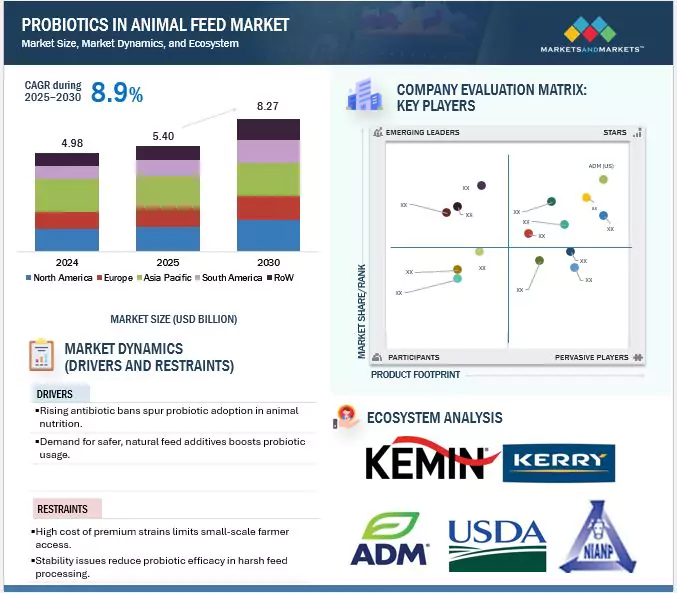The global probiotics in animal feed market is on a strong growth trajectory, projected to rise from USD 5.40 billion in 2025 to USD 8.27 billion by 2030, registering a CAGR of 8.9% during the forecast period. This growth reflects the increasing demand for sustainable livestock solutions, driven by the shift toward antibiotic-free production and the rising focus on animal health and productivity.

The global probiotics in animal feed market is flourishing, with rising demand and growing concerns over sustainable and antibiotic-free livestock production. Probiotics are being added to animal feed to improve gut health, improve immunity, improve feed efficiency, and reduce disease outbreaks. Rising farmer awareness, advancing microbiology, and antibiotic-resistance regulations are motivating further adoption. The trends in animal feed probiotics are particularly strong in the poultry, swine, and aquaculture sectors, as developing nations foster broad take-up levels, allowing a wealth of market opportunities.
Probiotics in Animal Feed Market Drivers: Rising demand for antibiotic alternatives
The worldwide move from antibiotic growth promoters (AGPs) in livestock farming is driving the adoption of probiotics as sustainable and viable alternatives. A research paper published by Frontiers in January 2024 found that escalating utilization of AGPs is generating increasing concern over antimicrobial resistance (AMR). The research demonstrated that probiotics, including many of the strains of Lactobacillus and Bifidobacterium, will inhibit the pathogens Clostridium perfringens and Salmonella while enhancing gut health, immunity, and nutrient absorption. Probiotics aid in supporting the gut barrier and pre-existing beneficial microbiota, which will assist in controlling infections and provide improvements to growth performance. The results clearly demonstrate the important contributions of probiotics moving towards sustainable livestock practices based on the responsible use of antimicrobials.
Poultry Leads the Market
Among livestock categories, poultry holds the largest share of the probiotics in animal feed market. Probiotics play a vital role in:
- Maintaining gut health
- Managing pathogen levels
- Enhancing immune function in birds
Balanced gut microflora is critical for nutrient absorption, digestion, and disease resistance, making probiotics indispensable in poultry farming.
With the intensification of poultry farming worldwide, producers are turning to probiotics as a sustainable alternative to antibiotics. In addition, advancements in probiotic formulations—especially those based on lactobacilli—and strong regulatory backing for natural feed additives further strengthen poultry’s dominant market position.
Download PDF Brochure: https://www.marketsandmarkets.com/pdfdownloadNew.asp?id=85832335
Dry Probiotics Dominate the Market
The dry form of probiotics leads the market, thanks to its practical benefits in handling, storage, and transportation. Key advantages include:
- Longer shelf life compared to liquid forms
- Lower risk of spoilage and contamination
- Cost-effectiveness for large-scale farming operations
These features make dry probiotics the preferred choice for producers, solidifying their position as the most widely adopted form in the animal feed industry.
Asia Pacific: The Fastest-Growing Region
The Asia Pacific region stands out as the fastest-growing market for probiotics in animal feed. Growth is fueled by:
- Rising awareness of animal health
- Rapid population growth and urbanization
- Expansion of the middle class
- Strong government support for sustainable farming practices
The demand for high-quality animal nutrition is surging, especially as livestock and poultry producers seek antibiotic alternatives to enhance productivity and meet consumer demand for safe, sustainable products.
- China leads the region as the largest egg producer with a vast livestock base, adopting advanced feed solutions at scale.
- Countries like India and Japan also play pivotal roles, with major manufacturers investing heavily in innovation and education efforts.
This momentum, combined with a shift toward eco-friendly farming, positions the Asia Pacific as a key driver shaping the global probiotics in animal feed market.
Leading Probiotics in Animal Feed Manufacturers:
The probiotics in animal feed market is highly competitive, with leading players expanding their global footprint through innovation and strategic initiatives. Key companies include:
- Evonik Industries AG (Germany)
- ADM (US)
- DSM-Firmenich (Switzerland)
- Novonesis (Denmark)
- International Flavors & Fragrances Inc. (US)
- Alltech (US)
- Kemin (US)
- Land O’Lakes, Inc. (US)
- Orffa (Netherlands)
- Lallemand Inc. (Canada)
- Lesaffre (France)
- Church & Dwight Co., Inc. (US)
- Phibro Animal Health Corporation (US)
- Sanzyme Biologics (India)
- Virbac (France)
These companies are investing in advanced probiotic formulations and integrated animal health solutions to address evolving industry needs. Strategic initiatives such as product development, partnerships, and mergers are enhancing their market presence while ensuring a diverse product portfolio that caters to poultry, swine, ruminants, aquaculture, and companion animals.
Recent Developments in the Probiotics in Animal Feed Industry:
- In March 2025, IFF launched its Enviva PRO three-strain Bacillus probiotic for swine in order to better support piglet gut health at the critical point of weaning. The advent of the product therefore also dedicated an addition to IFF’s animal nutrition portfolio. It gave the company the opportunity to tap into the increased demand for effective science-based products within livestock while allowing swine producers to increase animal welfare, productivity, and profitability.
- In March 2025, Orffa’s partnership with Florates strengthened its foothold in the probiotics in animal feed market by adding rapid, non-intrusive gut health diagnostics, giving producers access to live microbiome data for fast interventions, feed plan redesign, and improved animal outcomes, elevating Orffa’s part in delivering sustainable, data-based livestock management plans.


